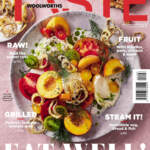How to take better food photos
Serious contender or Insta wannabe? These are our tips for taking better food photos.
The styling:
“Be brave and natural. If you want to get into the industry, find a photographer’s assistant – someone else starting out – and play with affordable dishes like toasted cheese, so that you can learn and build up a portfolio. And always have a bowl of iced water next to you to refresh the dish. I never put dry herbs on a plate, always dip them first.”
– Abigail Donnelly, TASTE food director
“Always shoot in natural light and with the freshest, most deliciously vibrant produce you can find.”
– Jacqueline Burgess, TASTE multimedia food stylist
“Always start with the simplest layout possible and add garnishes and other elements with each shot. It’s much easier to add than to take away, especially when things are prone to melting or mixing.”
– Hannah Lewry, TASTE food editor
In your tool box:
• Prestik and toothpicks: to keep round objects in place.
• A spray bottle filled with water: to keep ingredients fresh and beautiful.
• A blowtorch: to make chocolate glossy and char the edges of veggies.
• Metal skewers: to make griddle marks on meat.
• Surgical gloves: to avoid leaving fingerprints on chocolate.
• Eucalyptus oil: to remove stickers from packaging.
• Pins: to prevent chicken skin from shrinking when cooking – just make sure you count how many you use and remove them all before serving!
• Syringe: to add or remove liquid
• Paintbrushes: to paint vegetable oil onto meat.
• Burn Shield emergency dressings: they can make all the difference in a crisis.
The cooking:
“You have to be delicate and careful when you’re cooking the food for a shoot, so that it looks beautiful. Everything must be cooked with love. Being a food assistant is great because you learn how to fix recipes when they don’t work.”
– Kate Ferreira, food assistant
The props:
“Always choose props and backgrounds that will enhance the food, not fight with it. Look for plates that allow the colour of your dish to pop. Neutrals are always best when you’re starting out. Avoid using shiny plates, especially if you’re shooting using your smartphone.”
– Brita du Plessis of Check!MyChina, a prop shop for professional food stylists in Cape Town
The photograph:
TASTE photographer Jan Ras shares his tips for taking better phone photos:
• Wipe the camera lens (that blurry look is probably a fingerprint). • Hold the phone as steady as possible.
• Never use the zoom – rather get closer.
• Sit next to a window to get the best light. At night, or in bad light, don’t use your phone’s flash. Rather ask a friend to shine their cellphone’s torch onto the plate from behind. Use a napkin to diffuse the light if it’s too harsh.
• Try different angles and ways of framing a subject. For example, try cropping off one side of a plate, centring it, or shooting it from above.
• Switch on the HDR setting if your phone has one. HDR stands for “high dynamic range’ and will allow you to work with a greater range of light and dark (for example, if you want both the food and the view outside to be visible in a shot.)
• Looking for a new phone? Take test shots in store and compare the results. If you’re splashing out, look for a phone with multiple lenses, which will allow you to play with depth of field (when the background goes out of focus). Some new top-of-the-range models also have very effective night mode functions – great for shooting dinners.


Comments